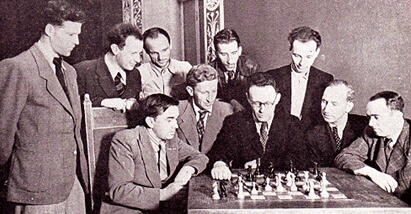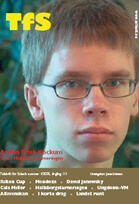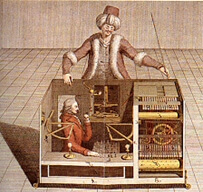Glossary |
|
Glossary - T
TN A theoretical novelty TACTICS Maneuvers carefully calculated to take advantage of opportunities arising in the short term. In carrying out the plan. Dr. Fine said: “Strategy, the body of ideas, holds only a framework. Tactics, the individual variation, is what goes into this framework.” TASK A chess problem (study) with a record number of repetitions of some idea. TELEGRAPH AND RADIO CHESS A form of chess not used any more where moves were sent by telegraph or radio using a code developed by Udemann. The first team match was played between Washington and Baltimore in 1844. Other high-level matches were the encounters between Chigorin and Steinitz in 1890, Paris and Petersburg in 1894-95 and a series of cable matches played between England and the USA between 1896 and 1911. Among the radio matches, two top events were organised in 1945 between the USSR and the USA and the USSR and Great Britain, both won by the Soviets 15½-4½ and 18-6, repectively.
The Soviet team of 1945 with Lilienthal, Boleslavsky, Makogonov, Bondarevsky, Bronstein. Seated: Kotov, Smyslov, Botvinnik, Ragozin and Flohr TELEPHONE MATCHES A form of chess tournaments using a telephone line connection. The first event took place in the USA between players in New York and Hartford in 1878. In the 1880s-90s, there were several tournaments between city chess teams in England. In the twentieth century, a telephone line was used for the competitions between city teams and matches between some chess players, e.g., an encounter between M. Euwe-M. Tal (1960-61), which ended with a draw. In the USSR, the most massive tourney over the telephone was the match on 100 boards between Moscow–Leningrad, won by the Moscow team 53,5-46,5. TELEX MATCHES A form of chess using a telex machine. One of the first official matches was organised in 1976 between the cities of London and Belgrade The first Olympiad (1977-78) was won by the USSR, which beat GDR in the final 5-3. The winning team was composed of Balashov, Vasjukov, Kochiev, Gufeld, Zaitsev, Palatnik, Akhmilovskaya and Dolmatov The second Olympiad (1981-82) was another triumph for the Soviets, this time with Yusupov, Balashov, Tseshkovski, Kupreichik, Taimanov, Agzamov, Levitina and A. Sokolov. TEMPO An Italian word meaning time. The unit of time expressed in terms of a move. A gain of time (move) during the game in that a player has gain or loss tempi. Tarrasch called it: “the time value for a move”. THEME Setting forth an idea. Often used by problemists. THREAT A move that threatens a piece or a position or that creates a positional weakness in the opponent camp. Nimzowitsch said: "The threat is stronger than its execution." THREEFOLD REPETITION The game is drawn if the same position occurs three times with the same player to move, and with each player having the same set of legal moves each time. THREE-MOVER An orthodox chess problem in which White must checkmate Black King in three moves. TIE-BREAK SYSTEM A procedure used in a tournament to find the winner of a group of players who have the same number of points. They are a few ways to break a tie in a Round Robin or a Swiss Open Tournament. One is to organise a play-off or a mini match between the two or more players involved. This way of ranking was often used in the recent KO World Championship Tournament but was also used before 1997 like at the Interzonal 1985, etc.; another way is to use the Sonneborn-Berger, Solkoff, Coons, Median Score or Buchholtz system. TIDSKRIFT FOR SCHACK
TIJDSCHRIFT VAN NEDERLANDSE SCHAAKBOND A Dutch chess magazine which has been published since 23 May 1893 (with a break 1943-45) and is still running. TIME CONTROL The first who were tough about time limitation were apparently St. Amand (Palmede 1836 p. 189) and Von der Lasa, who revived the idea in 1852. It was in Paris 1867 that the hour-glasses were first used. The limitation of time for an official game was first introduced in 1861 for the match between Anderssen and Kolisch to avoid unlimited time play, but it was in Paris 1867, that the hour-glasses were first used followed by a mechanical clock and recently by a digital clock. For classical chess, FIDE has adopted for its competitions 90 minutes plus an increment of a few seconds per move; however, many tournaments still use the popular 40 moves in 2 hour and one hour to finish the game. The Rapid Chess uses 25 minutes and an increment of a few seconds per move, and in Blitz Chess, each player has usually five minutes to finish the game. The time controls used:
TIME TROUBLE Also named zeitnot (in German), which is a situation when the player has only a little time to reach time control. TITLES Awards given by FIDE or national federations since 1950 to emeritus men or women players or arbiters of classic chess, correspondence chess or chess composition. Among them are International Grandmaster, International Master, FIDE Master, Candidate Master, National Master, International Arbiter, International Organizer, FIDE Arbiter and FIDE Trainer. TOUCH MOVE A chess rule which says if you touch a piece without saying J’adoube, you must move it. FIDE Regulations describe the possibilities in Article 4. 4.1 Each move must be made with one hand only. 4.2 Provided that he first expresses his intention (e.g., by saying "J'adoube" or "I adjust"), the player having the move may adjust one or more pieces on his squares. 4.3 Except as provided in Article 4.2, if the player having the move deliberately touches the chessboard.
4.5 If none of the pieces touched can be moved or captured, the player may make any legal move. 4.6 A player forfeits his right to a claim against his opponent's violation of Article 4.3 or 4.4, once he deliberately touches a piece. 4.7 When, as a legal move or part of a legal move, a piece has been released on a square, it cannot then be moved to another square. The move is considered to have been made when all the relevant requirements of Article 3 have been fulfilled. TRAINER A coach, a person who trains and helps youths or a candidate before or during a tournament. In 1998, FIDE formed a powerful Committee comprising of leading chess trainers around the chess globe. Accordingly, it was named the FIDE Trainers Committee. The number of certified FIDE Trainers has grown and they are now (in alphabetical order) - none other than: Alburt Lev (USA), Asanov Bolat (Kazahstan), Azmaiparashvili Zurab (Georgia), Boensch Uwe (Germany), Beliavsky Alexandr (Slovenia), Chernin Alexandr (Hungary), Dorfman Iossif (France), Dvoretsky Mark (Russia), Gelfer Israel (Israel), Georgadze Tamaz (Georgia), Gulko Boris (USA), Illescas Miguel (Spain), Kuzmin Alexey (Katar), Khodarkovsky Michael (USA), Leong Ignatius (Singapore), Mikhalcishin Adrian (Slovenia), Marjanovic Slavoljub (Serbia & Montenegro), Mohr Georg (Slovenia), Nikitin Alexandr (Russia), Petrosjan Arshak (Armenia), Polgar Zsuzsa (USA), Postovsky Boris (USA), Psakhis Lev (Israel), Razuvaev Yuri (Russia), Seirawan Yasser (USA), Sosonko Genna (Netherlands), Schmidt Wlodzimerz (Poland), Tukmakov Vladimir (Ukraine), Ubilava Elizbar (Georgia), Vladimirov Evgeny (Kazahstan), Zapata Alonso (Columbia) and Xie Yun (China). TRANSPOSITION In the opening, to play a usual sequence of moves and reach a standard position. For instance in the Panov attack of the Caro-Kann Defense, the position arisen is seen in the Queen’s Gambit Declined or the Nimzo-Indian Defence. TRAP An attempt to attract one's opponent into a line of play which should be advantageous by hoping for miscalculation or little care of the position. The most famous traps are the Blackburne trap, Lasker trap, Rubinstein trap, etc. TRIANGULATION A manoeuvre by the king that loses the move and set-up a zugzwang. TROITZKY MATE A bishop mate that was discovered by Troitzky in 1895. TRY A term used by the chess problemist Harley, a plausible first move that nearly, but not quite, solves the problem. TURK, the
TWO-MOVER An orthodox chess problem in which White must checkmate Black King in two moves. |
|||||||||||||||||||||||||||||||||||||||||||||||||||||||||||||





 A Swedish chess magazine which came out under the name Tidsskrift for Skak (1894-1901) and is still running.
A Swedish chess magazine which came out under the name Tidsskrift for Skak (1894-1901) and is still running. An automatic chess player constructed in Vienna in 1769 by Baron Wolfgang von Kempelen for the amusement of the court of the Empress Maria Theresa. The automation was a life-size figure dressed as a Turk, seated behind a chest the top of which was a chessboard. It was first exhibited in Vienna in 1770 and later brought to Dresden, Leipzig, Paris, London, and Amsterdam and then to the USA in 1826. Exhibited in the Chinese Museum of Philadelphia, it was destroyed by fire in 1854. Among the different players (usually of a small stature) were Allgaier (1809), Boncourt (1818), Lewis (1818-19), Williams (1819), Mouret (1820), Schlumbeger (1826 and later). About how it was operated H. J. R. Murray said: "The device was really quite simple: a strong magnet was fixed within the base of the chessman and from the inner surface of the chest, immediately below the board were suspended small iron balls by threads. As long the chessman stood on a particular square, the corresponding ball was attracted against the roof of the chess, and as soon it was lifted from its place, the ball fell to the length of the thread."
An automatic chess player constructed in Vienna in 1769 by Baron Wolfgang von Kempelen for the amusement of the court of the Empress Maria Theresa. The automation was a life-size figure dressed as a Turk, seated behind a chest the top of which was a chessboard. It was first exhibited in Vienna in 1770 and later brought to Dresden, Leipzig, Paris, London, and Amsterdam and then to the USA in 1826. Exhibited in the Chinese Museum of Philadelphia, it was destroyed by fire in 1854. Among the different players (usually of a small stature) were Allgaier (1809), Boncourt (1818), Lewis (1818-19), Williams (1819), Mouret (1820), Schlumbeger (1826 and later). About how it was operated H. J. R. Murray said: "The device was really quite simple: a strong magnet was fixed within the base of the chessman and from the inner surface of the chest, immediately below the board were suspended small iron balls by threads. As long the chessman stood on a particular square, the corresponding ball was attracted against the roof of the chess, and as soon it was lifted from its place, the ball fell to the length of the thread."